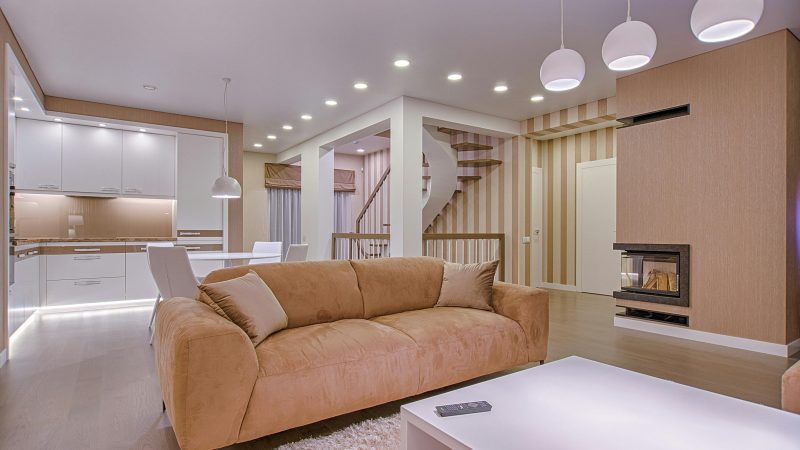Light is one of the most powerful tools in interior design — yet it’s often overlooked. A perfectly decorated room can still fall flat if it’s poorly lit, while a modest space can feel warm, elegant, and inviting with the right lighting. Beyond visibility, lighting shapes how we experience a room — how it feels, how we move, and even how we think.
Whether you’re renovating or simply refreshing your home, understanding the art of lighting can completely change the way you live in your space.
Why Lighting Matters in Interior Design
Lighting isn’t just a finishing touch — it’s part of the foundation of good design. It defines space, enhances textures, and sets the mood. The right lighting can make ceilings appear higher, colors more vibrant, and furniture more refined.
More importantly, lighting affects your emotions and productivity. Soft, warm lighting promotes relaxation, while bright, cool light enhances focus. The goal is to create a balanced lighting plan that supports both function and feeling — a space that works just as beautifully during a quiet evening as it does on a busy weekday morning.
- Understanding the Three Layers of Light
A well-designed home uses a combination of three main types of lighting: ambient, task, and accent. Each serves a distinct purpose, and together, they create balance and depth.
Ambient Lighting: Setting the Foundation
Ambient lighting is the general illumination of a room — the base layer that allows you to move around safely and comfortably. It usually comes from ceiling fixtures, downlights, or natural light sources like windows and skylights.
To make ambient lighting more inviting, avoid harsh glare. Use diffused lights, dimmers, or recessed fixtures to create a soft, even glow that spreads throughout the space.
Think of it as the gentle sunlight that fills your home on a calm morning — subtle, warm, and natural.
Task Lighting: Enhancing Focus and Function
Task lighting provides brightness where you need it most — for reading, cooking, grooming, or working. It’s directional and focused. Examples include pendant lights above a kitchen island, a desk lamp in your home office, or vanity lights in the bathroom.
Incorporate task lighting where precision is needed, but ensure it complements the overall ambiance. The best setups are both practical and beautiful — functional light that doesn’t interrupt the mood.
Accent Lighting: Adding Drama and Depth
Accent lighting is where personality shines. It draws attention to architectural features, artworks, or textures. Spotlights, wall washers, and LED strips under cabinets or behind mirrors all create visual interest.
A well-placed accent light adds luxury and dimension. Imagine a warm glow behind a feature wall or a hidden strip highlighting a floating shelf — these subtle touches turn an ordinary room into something extraordinary.
- Lighting and Mood: The Psychology of Illumination
Lighting directly influences mood. Too dim, and a space feels gloomy. Too bright, and it becomes harsh or sterile. The secret lies in control and layering.
Warm-toned lights (2700K–3000K) create coziness — ideal for bedrooms, dining areas, and living rooms. Cooler lights (3500K–5000K) energize — perfect for workspaces, kitchens, and bathrooms.
To adapt throughout the day, consider using dimmers or smart bulbs. They let you adjust brightness and color temperature, shifting the atmosphere from vibrant daylight to a soothing evening glow at the touch of a button.
- The Role of Natural Light
Before reaching for artificial solutions, maximize what nature already provides. Natural light enhances well-being, boosts mood, and makes any room feel more open and alive.
Use sheer curtains or blinds that filter rather than block light. Place mirrors opposite windows to reflect sunlight deeper into the room. Even a strategically placed glass partition can allow light to flow freely between spaces while maintaining privacy.
Homes that embrace daylight often feel larger, cleaner, and more connected to the outdoors — a vital quality in Singapore’s compact urban living environments.
- Lighting for Different Rooms
Each area of the home has its own lighting needs, and understanding these can elevate your entire design.
Living Room
This is where flexibility matters most. Combine ambient ceiling lights with floor or table lamps for mood control. Add accent lighting to highlight artwork, shelves, or feature walls. Layered lighting allows the room to shift seamlessly from bright for social gatherings to soft for movie nights.
Kitchen
The kitchen is both a workspace and a social hub. Pair bright task lights over countertops with warm ambient lighting to keep it welcoming. Pendant lights over an island not only add style but also help define the space visually.
Bedroom
Soft, layered lighting encourages relaxation. Wall sconces or pendant lights beside the bed free up space while providing gentle illumination for reading. Keep overhead lighting dimmable for better control over ambiance.
Bathroom
Lighting here should be functional yet flattering. Combine bright vanity lights with soft ambient options to create balance. Avoid harsh overhead light directly above the mirror, which can cast unflattering shadows.
- Common Lighting Mistakes to Avoid
- Relying on one light source:A single ceiling fixture creates flat, uneven lighting.
- Ignoring color temperature:Mixing warm and cool lights can make spaces feel disjointed.
- Overlooking dimmers:Dimmers are a simple, inexpensive way to make your lighting more dynamic.
- Neglecting shadow control:Harsh shadows around work areas or mirrors can disrupt function and comfort.
Thoughtful lighting design is as much about what you don’t illuminate as what you do.
- Bringing It All Together
Lighting isn’t a one-time decision — it’s a design journey. The best spaces evolve with your lifestyle and needs. A professional interior design company in Singapore can help you create a cohesive lighting plan that merges beauty with practicality, ensuring every switch, fixture, and glow has purpose and intention.
Experts understand how to balance natural and artificial light, coordinate color temperatures, and design lighting that enhances both architecture and mood — turning illumination into an art form.
A Brighter Way to Live
Light shapes how we see, feel, and experience our homes. It can turn a small apartment into an open haven, a dull corner into a cozy retreat, and a functional space into one that feels truly alive.
When you take lighting seriously, you don’t just brighten a room — you transform it. Thoughtful lighting creates balance, atmosphere, and emotion — the kind that turns a house into a home that glows, day and night.





